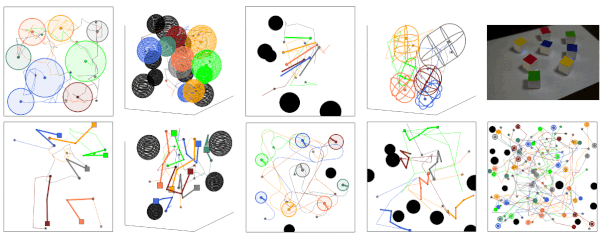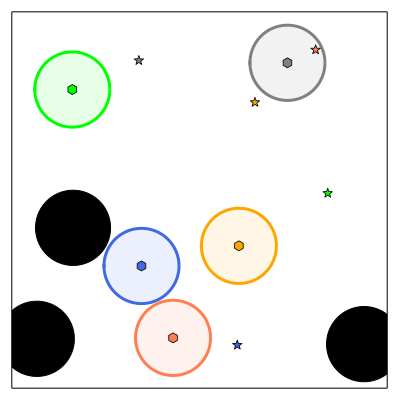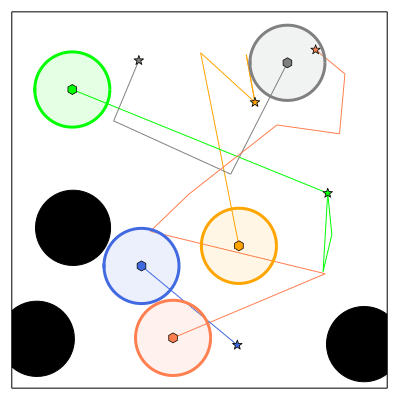The code repository of the paper "Quick Multi-Robot Motion Planning by Combining Sampling and Search" (SSSP).
- It is written in Julia (≥v1.6) and tested on MacOS-10.15.
- The accompanied solvers are PRM [1], RRT [2], RRT-Connect [3], PP (PRM-based) [4], CBS (PRM-based) [5], and SSSP.
Please cite the following paper if you use the code in your published research:
@article{okumura2022sssp,
title={Quick Multi-Robot Motion Planning by Combining Sampling and Search},
author={Okumura, Keisuke and D{\'e}fago, Xavier},
journal={arXiv preprint},
year={2022}
}
git clone https://github.com/Kei18/sssp.git && cd sssp
julia --project=. -e 'using Pkg; Pkg.instantiate()'Here, I give a minimal example of the MRMP library. You can implement the below with RELP or JupyterLab.
julia --project=.julia --project=. -e "using IJulia; jupyterlab()"import Random: seed!
using MRMP
seed!(46)
ins = MRMP.gen_random_instance_StatePoint2D(;
N = 5,
rad = 0.1,
num_obs = 3,
rad_obs = 0.1,
)
config_init, config_goal, obstacles, ins_params... = ins # example of ins_params: radius, base positions of armsThe first time may take time for JIT compiling.
With jupyterlab, you can visualize the generated instance as follows:
MRMP.plot_instance!(ins...)connect = gen_connect(config_init[1], obstacles, ins_params...) # connection checker
collide = gen_collide(config_init[1], ins_params...) # collision checker
check_goal = gen_check_goal(config_goal) # goal judge@time solution, roadmaps = MRMP.Solvers.SSSP(
config_init,
config_goal,
connect,
collide,
check_goal;
TIME_LIMIT = 10,
)
validate(config_init, connect, collide, check_goal, solution) # check validity of solution(TPG, solution, cost) = smoothing(solution, connect, collide)
println(cost)plot_anim!(config_init, config_goal, obstacles, ins_params...; solution=solution, interpolate_depth=2)You now get tmp.gif like below.
julia --project -e 'using Pkg; Pkg.test()'julia --project=. -e 'using JuliaFormatter; format(".")'Hyperparameter Optimization with Hyperopt.jl
julia --project=. --threads=auto
> include("./scripts/hypraopt.jl")
> @time main("./scripts/config/hypra/params.yaml", "./scripts/config/eval/point2d.yaml")julia --project=. --threads=auto
> include("./scripts/eval.jl")
> @time main("./scripts/config/eval/point2d.yaml", "time_limit=300")julia --project=. --threads=auto
> include("./scripts/eval.jl")
> @time foreach(N -> main("./scripts/config/eval/point2d_many.yaml", "instance.N=$N"), 10:10:50)julia --project=. --threads=auto
> include("./scripts/eval.jl")
> @time main("./scripts/config/eval/point2d_ablation.yaml")julia --project=.
> include("./scripts/server.jl")
> # To close the server, just run `close()`- Several planning examples are available in
./notebooks. - The evaluation script is inspired by Hydra.
- Dubins paths are computed by Dubins.jl.
This software is released under the MIT License, see LICENSE.txt.
Keisuke Okumura is a Ph.D. student at the Tokyo Institute of Technology, interested in controlling multiple moving agents.
- Kavraki, L. E., Svestka, P., Latombe, J. C., & Overmars, M. H. (1996). Probabilistic roadmaps for path planning in high-dimensional configuration spaces. IEEE transactions on Robotics and Automation.
- LaValle, S. M. (1998). Rapidly-exploring random trees: A new tool for path planning.
- Kuffner, J. J., & LaValle, S. M. (2000). RRT-connect: An efficient approach to single-query path planning. In ICRA.
- Erdmann, M., & Lozano-Perez, T. (1987). On multiple moving objects. Algorithmica.
- Sharon, G., Stern, R., Felner, A., & Sturtevant, N. R. (2015). Conflict-based search for optimal multi-agent pathfinding. Artificial Intelligence (AIJ).




